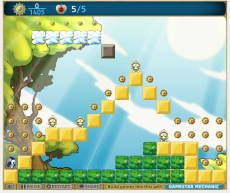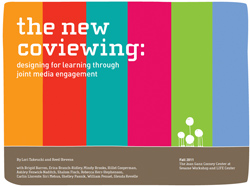What makers of technology for early education can learn from Sesame Street.
Whether you’re at a restaurant or on an airplane, you can’t miss changes in adult-child interactions from just a generation ago. Everyone is plugged in. It seems almost quaint to see kids and adults engaged together in screen-free play. Four-year-olds now consume three hours of media per day, and fourth graders more than five hours. And it is not just youth—adults are also increasingly finding it difficult to turn off their digital lives. This has inspired a tremendous amount of philosophizing about how smartphones, iPads, and gaming consoles may be hurting both childhood and parenting.
But given that the number and variety of digital options will only increase, wouldn’t it be more productive to explore how we can effectively transform media consumption into quality family time? What if we viewed the digital deluge as a new opportunity to tap into the potential of interactive technologies to help reunite generations in playful learning together? In recent years, a great deal of attention has been paid to the potential of video games for good—President Obama has even appointed an expert adviser who is fashioning the first national policy initiative on video games’ role in education, health, the environment, and numerous other areas. But a vital component of games in the public interest has remained largely overlooked: intergenerational gameplay.
To understand why intergenerational gameplay is so important, let’s go back a half-century. In the 1960s, a generation of parents worried that children were being hypnotized by the television. Policymakers, educational psychologists, and parents were all concerned that the “boob tube” was hurting kids’ development. FCC Chairman Newton Minow famously referred to television as a “vast wasteland” when challenging broadcasters to embrace programming in the public interest.
This call-to-action prompted pioneers such as Joan Ganz Cooney and Lloyd Morrisett to pursue a simple but revolutionary idea: use TV to teach the basic skills and values that children would need to begin school. Their response to Minow’s challenge was Sesame Street. World-class creative talents like Jim Henson joined leading educators to create television content that would engage both the child and the parent. In addition to providing great entertainment grounded in research, the programming fostered “co-viewing.” Children who watched Sesame Street with their parents learned more from the show than those who watched it alone. Parents encouraged their kids to apply their own background knowledge to what they saw onscreen—so when they saw a word or a number they might count further or recite the alphabet.
Now, more than 40 years later, Sesame Street remains a preschool staple, positively impacting youth throughout the world. In fact, the success of the format has stimulated an entire media industry sector with tens of thousands of engaging educational programs on various platforms that parents and children enjoy together.
In many ways, today’s video games are analogous to television in the 1960s. The perception of many policy makers, educators, and parents is that video games are “a vast wasteland.” Certainly video games have become ubiquitous; 80 percent of 5- to 8-year-olds regularly play games. The number increases to 97 percent for teens.
So, can a portion of the billions of hours of highly engaged, “lean-forward” participatory video-gaming be channeled toward research-based intergenerational games? Can we convince deeply skeptical moms and dads to embrace the medium not as a distraction or baby-sitter but as a means to engage with and empower their children? Will we be able to entice increasingly sophisticated youth gamers to engage with their newbie parents, perhaps taking on the role of mentor and guide? Accomplishing these goals will not only foster more valuable family time—it has the potential to drive meaningful learning and literacy gains.
There is an emerging body of research highlighting the great potential of intergenerational gameplay. For example, in 2009, the Joan Ganz Cooney Center (which one of us directs) and the University of Southern California studied video game play between adults and elementary school children. They found that kids were more engaged in learning with digital games than traditional board games and that adults learned technology skills from their kids. This work helped inspire an intergenerational game,Electric Racer, to help children and adults play together to deepen family literacy skills development. Another recent research report developed by the National Science Foundation-funded LIFE Center (based at the University of Washington, Stanford, and Northwestern) and the Cooney Center presents six case studies on the subject and found, among other things, that “joint media engagement is often initiated by children rather than parents.”
“Intergenerational” doesn’t just mean a parent and child, though. Another effort, developed by the Nokia Research Laboratory and the Cooney Center, revealed that preschool youngsters who read books together with their grandparents via a richly designed e-book delivered during a video conference call were more engaged in reading and more likely to spend additional time in early literacy experiences than children who spoke with grandparents via telephone.
Compelling intergenerational gameplay may also help demystify the medium for skeptical parents by helping them tell the difference between when their children are in a very productive “flow” state and when they are zoning out and in digital overload. This could help both parents and children learn better approaches to self-regulating their screen time, maybe even encourage industry to design game mechanics to foster self-regulation, like having characters get tired after excessive gameplay or providing special power-ups for taking a well-timed break.
For intergenerational games to be effective, though, they need to be designed to account for children’s very varied economic and cultural backgrounds. Research needs to help tease out which game mechanics are most likely to engage both parents and children from different backgrounds. If done successfully, perhaps we can even use games to attack stubborn intergenerational national problems that even Sesame Street has been unable to overcome, such as the lack of rich early literacy experiences in low-income homes or the obesity epidemic.
The more parents explore games with their kids, the more they will be equipped to seek out ones that provide engaging learning experience. This could then drive the game industry to take advantage of the burgeoning market stimulating more innovation. Maybe then video games will be as influential (in a good way) as Sesame Street has been for the past three generations.
This article was first published on Future Tense, a partnership of Slate, the New America Foundation, and Arizona State University that examines emerging technologies and their effects on policy and society, and appears here with permission.




